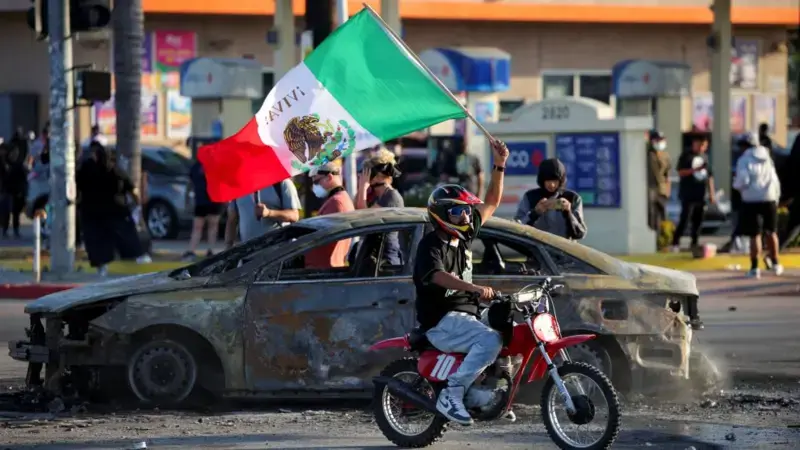A wave of unrest has erupted across Los Angeles following sweeping U.S. Immigration and Customs Enforcement (ICE) raids targeting undocumented migrants. These events have escalated into street riots in Latino-majority areas like Paramount and Compton, prompting President Donald Trump to federalize the California National Guard and threaten active-duty Marine deployment.
Where in LA Are the Riots Happening?

The most intense clashes occurred in:
-
Paramount and the Fashion District, where ICE conducted targeted sweeps at workplaces including Home Depot, doughnut shops, and warehouses.
-
Compton, where bystanders reported people throwing Molotov-style bottles at federal agents.
-
Downtown Los Angeles, notably around the 101 Freeway and City Hall, where students staged mass walkouts and freeway blockades to protest the raids.
Law enforcement responded with tear gas, flash-bangs, and stun grenades to scatter groups that threw debris and launched attacks on ICE and Border Patrol officers.
Why Are There Riots in LA?
The unrest stems from a series of aggressive ICE enforcement actions under President Trump’s second-term immigration policies:
-
ICE Raids Across Multiple Sites
Beginning June 6, ICE made mass arrests—reportedly between 44 to 118 individuals—during coordinated sweeps based on suspected forged documents. These included offices, retail locations, and factories. -
Community Outrage Over Deportations
Many detainees claimed to have fled horrific violence in their home countries. Communities rallied around families, especially after footage emerged of officers detaining individuals—including children—on everyday errands. -
Broader Tensions Over Sanctuary Policies
LA’s sanctuary-city stance has long conflicted with federal priorities. Protests have been ongoing in opposition to aggressive immigration enforcement, and this month’s raids reignited widespread anger.
National Guard in LA — A Trump Decision
On June 7, President Trump authorized 2,000 federalized California National Guard troops under Title 10, bypassing Governor Gavin Newsom’s usual authority. He cited the need to “protect federal property” and enforce law and order amid protests.
Defense Secretary Pete Hegseth warned that active-duty Marines stationed at Camp Pendleton were on “high alert” and could be deployed if violence escalates.
California Leaders Push Back
Governor Gavin Newsom denounced the federal move as an overreach, calling it “purposefully inflammatory” and warning it would escalate tensions without cause. He asserted that local law enforcement had the situation under control.
Los Angeles Mayor Karen Bass echoed the criticism, saying local leaders had not requested National Guard support and branded Trump’s order a “political spectacle.” The city issued warnings during “unlawful assembly” incidents, urging peaceful expression.
Senators Adam Schiff and Alex Padilla called the deployment “unprecedented” and accused the Trump administration of inflaming chaos and division.
Is the National Guard Already Active?
Despite federal orders, as of early June 8, the National Guard had not been deployed in protest zones. Local authorities, including the Los Angeles County Sheriff’s Department and Mayor Bass’s office, confirmed that the troops had not yet arrived on the ground.
So What Can We Expect Next?
-
ICE continues raids — Federal enforcement is ongoing, with additional operations likely.
-
Trump warns of escalation — He has promised zero tolerance toward what he calls “radical left protests” and “paid troublemakers.”
-
Local leaders urge peace — California officials continue to encourage peaceful protest to avoid justifying federal military involvement.
What began as a federal crackdown on undocumented migrants in Los Angeles has spiraled into citywide unrest. President Trump’s National Guard intervention signals a significant escalation that pits federal authority against local control. As protests deepen and ICE operations persist, California braces for more friction—and the nation watches closely. Whether this moment becomes a temporary flashpoint or a defining shift in U.S. immigration policy remains to be seen.




